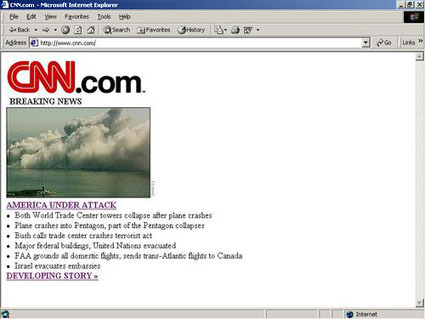9/11 and the Internet: Limits and opportunities
Introduction
New York (NY) - Tuesday, 9/11 2001, 8:45 am. Shortly after American Airlines flight 11 had slammed into the north tower of the World Trade Center, the Internet was hit by an aftershock: Hundreds of millions of users flooded the Web in search of information and opportunities to communicate. Numerous websites collapsed and became images for the unpredictability of the Net. But did the Internet really fail that day?
It was exactly five years ago today on which a series a coordinated suicide attacks shook the nation and killed 2973 people, not including the 19 hijackers who crashed two planes into the World Trade Center, one into the Pentagon and were responsible for another crash near Shanksville, PA. Whether people were directly affected by the attacks or not, whether they lived in the U.S. or not, the massive scope of the events highlighted a common thirst for information and need for communication. And for the very first time in history, the Internet became an instrumental tool to stay informed and keep the contact with loved ones.
Unfortunately, an unprecedented flood of people did not only disrupt cellphone networks, but also Internet capacity. The grade of disruption was substantial enough to question, if the Internet could ever be relied on in a time of crisis.
CNN's homepage on 11 September 2001
The Los Angeles Times, for example, criticized "the network designed to survive a nuclear war failed" which "highlights the weakness of a medium not ready to compete with the reach and immediacy of television and radio" on 12 September, 2001. And even Mark Bercow vice president of wireless equipment maker Atheros told Eweek that "it really exposes the immaturity of the Internet when you try to do what it was meant for and you can't."
Get Tom's Hardware's best news and in-depth reviews, straight to your inbox.
Tom's Hardware is the leading destination for hardcore computer enthusiasts. We cover everything from processors to 3D printers, single-board computers, SSDs and high-end gaming rigs, empowering readers to make the most of the tech they love, keep up on the latest developments and buy the right gear. Our staff has more than 100 years of combined experience covering news, solving tech problems and reviewing components and systems.

